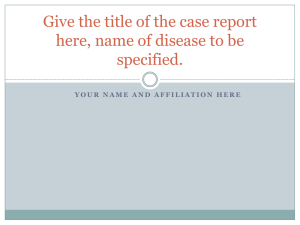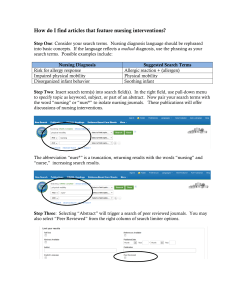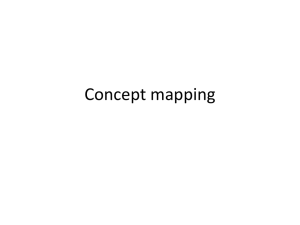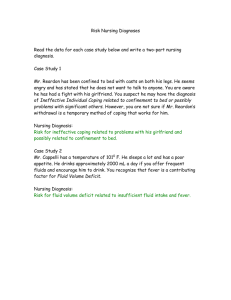Care Plan
advertisement
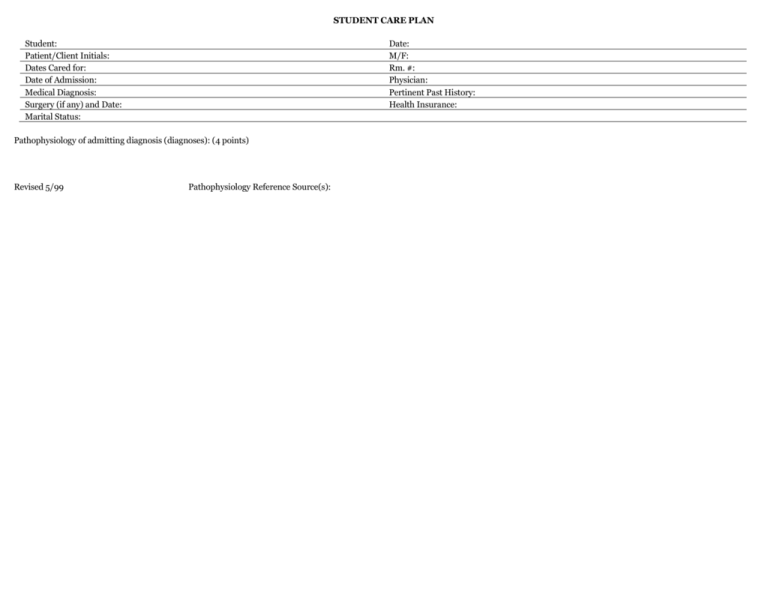
STUDENT CARE PLAN Student: Patient/Client Initials: Dates Cared for: Date of Admission: Medical Diagnosis: Surgery (if any) and Date: Marital Status: Date: M/F: Rm. #: Physician: Pertinent Past History: Health Insurance: Pathophysiology of admitting diagnosis (diagnoses): (4 points) Revised 5/99 Pathophysiology Reference Source(s): Nursing Assessment Criteria - (2 points) From the pathophysiology textbook or components of Medical-Surgical text. SUBJECTIVE: OBJECTIVE: PSYCHOSOCIAL: RISK FACTORS: Ref: For acquiring the disease or condition. (May be found under etiology). GORDON'S FUNCTIONAL HEALTH PATTERNS STUDENT ASSESSMENT GUIDE (22 points) #1 HEALTH MAINTENANCE MGMT. Admit Date SUBJECTIVE OBJECTIVE SUBJECTIVE OBJECTIVE Medical Diagnosis Pertinent medical history Pertinent psychosocial history Insurance Age Allergies-Food and medicines Erikson's Developmental Level Tendency toward which pole Perception of health status Immunization status Risk behaviors Discharge needs Medications prior to admission #2 NUTRITION/METABOLIC Diet Recent intake (% of meals) Food preferences Abdomen Bowel sounds Nausea NG Tube IV Fluids Intake/Output (no. of hours) Temperature Edema Height, Weight Body Mass Index #3 ELIMINATION Bladder SUBJECTIVE OBJECTIVE Bowel patterns Last BM Skin Braden scale score #4 ACTIVITY/EXERCISE Respiratory - Rate Character of respirations SUBJECTIVE OBJECTIVE Color Breath sounds SpO2 Cardiac Apical pulse (rate, rhythm, sounds) Peripheral pulses Capillary refill time Blood pressure Homan's sign ROM Mobility (describe extent) Assistive equipment ADL performance Leisure and recreation #5 COGNITIVE/PERCEPTUAL Pain (scale, characteristics) SUBJECTIVE OBJECTIVE SUBJECTIVE OBJECTIVE Glasgow score Sensory aids Level of consciousness Circulation, Motion, Sensation (CMS) #6 SLEEP/REST Pattern of Sleep Quality/Quantity #7 SELF-PERCEPTION/SELF-ESTEEM Describes attitudes about self and perception of abilities. SUBJECTIVE OBJECTIVE SUBJECTIVE OBJECTIVE Attitudes about self Impact of illness on self Desire to change self Nervous or relaxed: rate 1-5 Perceived powerlessness Body posture Eye contact Assertive or passive: rate 1-5 Nonverbal cues to altered self-esteem Facial expressions #8 ROLE/RELATIONSHIP Occupation Recent change in Role Comfort with Change Marital Status Family structure #9 SEXUALITY Menstrual history: children SUBJECTIVE OBJECTIVE SUBJECTIVE OBJECTIVE Self-breast/testicular exams Impact of illness on sexuality Birth control #10 COPING/STRESS Expression of stress Stressors Usual coping mechanisms Support systems Family support Community resources #11 VALUE/BELIEF Religious Preference Spirituality Cultural beliefs and practics Practice of values/beliefs Advanced directives DNR SUBJECTIVE OBJECTIVE STUDENT CARE PLAN Laboratory Diagnostic Studies (2 points) - Relevant at this time: DATE TEST NORMAL VALUE PATIENT/CLIENT VALUE REASON FOR TEST, SIGNIFICANCE OF ABNORMAL RESULTS FOR THIS PATIENT Reference: Radiological Diagnostic Studies - Relevant at this time. DATE Reference: TEST FINDINGS, SIGNIFICANCE FOR THIS PATIENT MEDICATION WORKSHEET - (5 POINTS) CLASSIFICATION MEDICATION USUAL DOSAGE ROUTE MECHANISM OF ACTION DRUG INTERACTIONS TOXIC/SIDE EFFECTS NURSING INTERVENTIONS Current medical orders that form the basis for collaborative care: (1 point) ARENA ASSESSMENT - (3 points) How does each arena contribute to physical and psychosocial-spiritual well-being? A. Agency a. Physical b. B. Family a. Physical b. C. Psychosocial-spiritual Psychosocial-spiritual Community a. Physical b. Psychosocial-spiritual STUDENT CARE PLAN WORKSHEET – (6 points) STRENGTHS WEAKNESSES PRIORITIZE THREE AREAS OF CARE RATIONALE FOR Prioritize for Care AND STATE EACH PROBLEM AS A PRIORITIZATION OF PROBLEMS Using Maslow’s Hierarchy of NANDA DIAGNOSIS DISCHARGE GOALS Needs 1. 2. _________________________________________ TEACHING NEEDS _________________________________________ 3. Student Name: 2 p NURSING DIAGNOSIS DEFINITION: Patient’s Medical Diagnosis: DEFINING CHARACTERISTICS: o i n RELATED FACTORS: t STUDENT INSTRUCTIONS: s A S S E S S M E N T D I A G N O S I S In the space below enter the subjective and objective data gathered during your patient assessment and include the appropriate Gordon’s Functional health Pattern. Subjective Data Entry (1 point) Time Out! Student Instructions: To be sure your patient diagnostic statement written below is accurate, you need to review the defining characteristics and related factors associated with the nursing diagnosis and see how your patient data matches. Do you have an accurate match or is additional data required or does another nursing diagnosis need to be investigated? PATIENT Nursing Diagnosis (specify) DIAGNOSTIC Related to STATEMENT: (2 points) Objective Data Entry (1 point) DESIRED OUTCOME: (2 points) A. INTERVENTION (2 points) B. RATIONALE (reference) (2 points) D. Sample documentation or charting of nursing care and patient response. (2 points) E. Was the desired outcome achieved? (1 point) C. EVALUATION (2 points) Student Name: 2 p NURSING DIAGNOSIS DEFINITION: Patient’s Medical Diagnosis: DEFINING CHARACTERISTICS: o i n RELATED FACTORS: t STUDENT INSTRUCTIONS: s A S S E S S M E N T D I A G N O S I S In the space below enter the subjective and objective data gathered during your patient assessment and include the appropriate Gordon’s Functional health Pattern. Subjective Data Entry (1 point) Time Out! Student Instructions: To be sure your patient diagnostic statement written below is accurate, you need to review the defining characteristics and related factors associated with the nursing diagnosis and see how your patient data matches. Do you have an accurate match or is additional data required or does another nursing diagnosis need to be investigated? PATIENT Nursing Diagnosis (specify) DIAGNOSTIC Related to STATEMENT: (2 points) Objective Data Entry (1 point) DESIRED OUTCOME: (2 points) . A. INTERVENTION (2 points) B. RATIONALE (reference) (2 points) D. Sample documentation or charting of nursing care and patient response. (2 points) E. Was the desired outcome achieved? (1 point) C. EVALUATION (2 points) Student Name: 2 p NURSING DIAGNOSIS DEFINITION: Patient’s Medical Diagnosis: DEFINING CHARACTERISTICS: o i n RELATED FACTORS: t STUDENT INSTRUCTIONS: s A S S E S S M E N T D I A G N O S I S In the space below enter the subjective and objective data gathered during your patient assessment and include the appropriate Gordon’s Functional health Pattern. Subjective Data Entry (1 point) Time Out! Student Instructions: To be sure your patient diagnostic statement written below is accurate, you need to review the defining characteristics and related factors associated with the nursing diagnosis and see how your patient data matches. Do you have an accurate match or is additional data required or does another nursing diagnosis need to be investigated? PATIENT Nursing Diagnosis (specify) DIAGNOSTIC Related to STATEMENT: (2 points) Objective Data Entry (1 point) DESIRED OUTCOME: (2 points) example sentence to show the use of underlining. A. INTERVENTION (2 points) B. RATIONALE (reference) (2 points) D. Sample documentation or charting of nursing care and patient response. (2 points) E. Was the desired outcome achieved? (1 point) C. EVALUATION (2 points) REFERENCE PAGE
